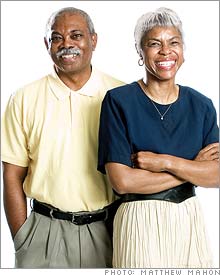|
Make a dream retirement real This doctor and his wife imagine a retirement filled with daily bike rides and a cross-country road trip. These portfolio fixes can help them get there.
NEW YORK (MONEY Magazine) -- After a quarter-century on call, Dr. Calvin Dixon is making plans to go off duty. In eight years, the 57-year-old pulmonologist would like to shed the demands of his Dallas-area practice and retire. He'll trade his stethoscope for a stack of books, ride his bike every day and finish the 50-state tour that he and his wife Daisy started when their two children were young.
He may even see the occasional patient. "I would like to continue to do something, but maybe part time," he says. "Something less stressful and less time consuming." But now the Dixons wonder if they are on track for the retirement that Calvin imagines. He has always earned a good living, and the Dixons have avoided debt. At the same time, they have made big outlays, starting with the cash they spent to build their new home. They've given generously to charity (including tithes to their church). And they've splurged on household luxuries. Saving for retirement, however, hasn't been a top priority until now. "This is the time we can save," says Daisy, 56. "We just don't know how much we need." Along with funding retirement, they'd like to pay 28-year-old Calvin Jr.'s first-year law school tuition if he's accepted, help their 24-year-old daughter Dwan with grad school and keep giving to charity. "When the money is there, we're willing to give to organizations we believe in," says Daisy. "But when the money isn't there, we give what we can." Where they are now Calvin's income fluctuates, and in 2005 it topped $200,000. Each year Calvin makes the $12,500 maximum contribution to his Simple IRA, a small business retirement plan. Daisy, a medical technologist, works part time for Calvin and draws a salary that covers her IRA contribution. Last year they gave $40,000 to charity, spent $35,000 on home improvements and saved another $7,200. In retirement, the Dixons would like an annual income of $96,000. To cover that, they have $335,600 spread among different IRAs and brokerage accounts. About 65% of their money is in stocks (nearly all large-caps), 18% is in bonds, and 17% is in cash. They're also planning to sell Calvin's practice, which they value at $200,000. What they should do At their current rates of saving and investing, the Dixons can fund only eight years of their dream retirement, says Matt Paladini, a financial planner in Dallas. To get to the $96,000 they want, he says, they'll need to save $55,000 a year. If they miss the target, they won't be destitute - they'll just have to cut back a little. Here's how they can give it a shot. SWAP THE SIMPLE In place of the pair's IRAs, Paladini suggests, Calvin might set up a 401(k) plan for his practice. It's costlier and will require extra paperwork but will let the Dixons save more money on a tax-favored basis. At their age, Calvin and Daisy (after a raise) could each contribute $20,000 of their salaries. With additional profit sharing (for all of Calvin's employees), the Dixons could defer taxes on thousands more from the practice each year. FIND A BUYER The sooner Calvin can get money out of his practice, the sooner it can be invested. Rather than wait until 65 to cash out, says Paladini, Calvin should add a younger partner in two years and sell his practice to that doctor over time. GET A LOAN FOR LAW SCHOOL Though the Dixons loathe debt, borrowing might help a little. Instead of their ponying up for Calvin Jr.'s first-year tuition, says Paladini, their son can take out a student loan that they can pay off later. If the Dixons invest what they've earmarked for school, they could, depending on the loan terms, earn more than the debt will cost them. THINK SMALL On top of the additional savings, Paladini continues, the Dixons need a 9% annual return on their portfolio over the next eight years for this plan to work. Holding so much cash and not diversifying beyond large-caps lessens the chance they'll clear that bar. Paladini advises them to cut their large-cap position to 36%, add a 6% stake in the midcap Meridian Growth fund (MERDX (Charts)) and add another 6% to small-cap funds T. Rowe Price New Horizons (PRNHX (Charts)) and Vanguard Small-Cap Index (NAESX (Charts)). Another 8% of their portfolio should be in international stocks, 4% should go to real estate, and 35% should be in fixed income. Even after these moves, the Dixons have only a 63% chance of amassing the wealth they want, says Paladini. But their odds improve, he says, if Calvin works one more year or if they can live on $6,000 less a year. Both options are acceptable to them. "I remember when we didn't have much at all," says Daisy. "So we can make do with less." _____________________________ Want a Money Makeover? E-mail us at makeover@moneymail.com. |
|

